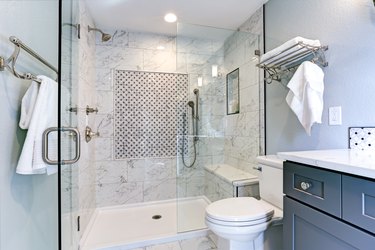
Is it time for a tub makeover? If tiling your tub surround is part of your bathroom remodeling plans, you'll need to dust off your math skills to calculate how much tile you need. Crunching the numbers isn't too difficult, and you have some wiggle room since you'll want to get a few extra tiles anyway.
Plan Your Tile Surround Design
Video of the Day
Before you calculate tile requirements, decide on a tile design. Some people choose all one type for the entire surround. Others incorporate different tiles. You might do a row of a different style of tile around the tub surround, for example.
Video of the Day
You also need to know how high you want to tile the tub surround. If you have a shower in the tub, the tiles should typically reach at least 6 feet above the floor. Check with local building codes to determine if there's a minimum required height. You can also take the tile to the ceiling for a more dramatic look and for more wall protection.
Take Tub Surround Measurements
Now that you know where your tiles will go and how high they'll extend, grab your tape measure to take the measurements for the surround. You'll want to measure each of the three walls for the tub surround for your alcove tub and record the measurements for each. Measure the height and width of each section; then multiply the numbers to get the total area of that wall. Add up the square footage for all sections to get your total.
Calculate for Different Tiles
If you're doing sections of different tile, you'll need to calculate those separate sections. For instance, if you're doing a single row of glass tiles within the ceramic tiles around all three walls, you'll need to calculate that area separately.
Determine the height of the tiles you're going to use for the special section. Measure the width of all three walls and multiply that number by the height of the tile. If the height is in inches, convert the width to inches; then divide the answer by 12. This number gives you the square footage for the special section. Subtract that amount from the overall square footage to determine how much of your main tile you'll need.
Figure in Overage
If you have purchased the exact amount you need to cover your tub surround, prepare to head back to the hardware store for more tiles. It's always a smart idea to add 10 to 20 percent overage to your calculated amount when tiling a shower to account for issues. You might break a tile while you're handling it or cut a tile incorrectly. You might need some extra pieces to finish out rows. It's also a good idea to have some extras on hand in case you need to replace a tile in the future.
To calculate the overage, multiply the square footage by 1.1 for 10 percent overage or 1.2 for 20 percent overage. Say you need 80 square feet to cover the area, and you want to buy 20 percent overage. Multiply 80 by 1.2 to get 96 square feet, which is how much tile you should purchase.
Calculate the Number of Tiles
Tiles for tub surrounds are available individually or in boxes, depending on where you purchase them and which tiles you choose. If you're buying by the box, calculate how many boxes you need by the square footage each box covers. Say one box covers 12.5 square feet, which is a common option. If you need 96 square feet of tile, divide 96 by 12.5 to get 7.68. Then round up to eight boxes to ensure you have enough tile.
If you're buying individual tiles, determine how much each tile covers. A 12-inch by 12-inch tile is easy to calculate since each one covers 1 square foot. Smaller tiles cover less, so you'll need to do a little math. If each tile covers 0.81 square feet, divide the total you need, such as 96 feet, by 0.81, which gives you 118.5. In this example, you would need to buy 119 tiles to provide enough coverage.